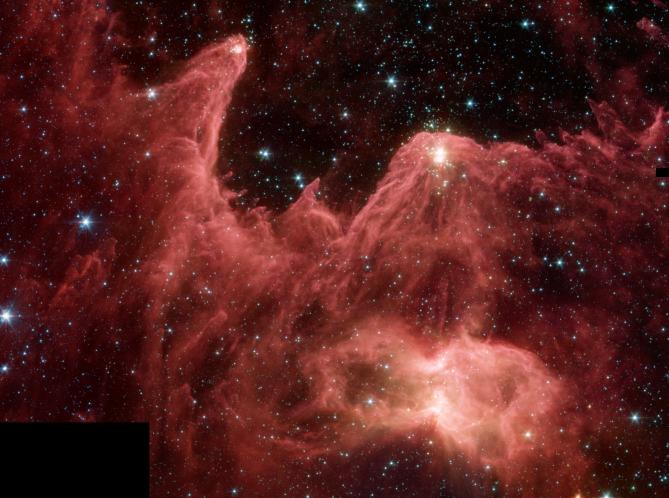
home •
about •
essential guide •
picture of the day •
thunderblogs •
news •
multimedia •
predictions •
products •
get involved •
contact
picture of the day archive subject index
Credit: NASA/JPL-Caltech/Harvard-Smithsonian CfA/ESA/STScI
Jun 04, 2007
Mountains of Creation Create a CometPopular theories dominated by metaphors of weather and weathering fail to apprehend actual conditions. An awareness of plasma behavior makes possible a more realistic view.
The popular theories of star formation see in this image “thick and turbulent clouds of gas and dust” that are “being sculpted into pillars by radiation and winds from hot, massive stars.”
“Radiation and winds from the massive stars subsequently blast the cloudy material outward, so that only the densest pillar-shaped clumps of material remain. The process is akin to the formation of desert mesas, which are made up of dense rock that resisted water and wind erosion.... [T]he pillars eventually become dense enough to spur the birth of a second generation of stars.”
The unreliable confidence that arises from having only one model with which to interpret meager data leads to this kind of sloppy use of language. The “thick” clouds are less dense than any vacuum that can be produced on Earth. They are almost certainly not “gas and dust,” which are subject primarily to forces of gravity and collisions. They are plasma, which is subject primarily to forces of electromagnetism. No doubt there are dust particles and gas molecules present: The important distinction is in how we think about them—whether as metaphorical desert rocks that are eroded by fluid agents or as cosmic currents that are shaped by electrical discharge.
And as plasma, the clouds are almost certainly not “turbulent.” Hannes Alfven, the Nobel Laureate father of plasma cosmology, warned astrophysicists, “The sloppy use of the term ‘turbulent’ has caused, and is causing, much confusion.... [T]here is no certain indication than anywhere in space there is very much (large scale) turbulence in the proper sense of the word.... [R]eal turbulence produces mixing.... On the contrary, [in space plasmas] a separation of elements often takes place.” [Alfven, Cosmic Plasma, 1981, pp. 42-3. Emphasis in original.]
As plasma, the pillars are examples of this separation. The denser dusty plasma inside the pillars is being separated from the transparent plasma outside by double layers. The cosmic currents flowing around and through the dusty plasma show up as filaments inside the pillars. (If the dense head of the pillar were merely shielding “gas and dust” from a wind, structure within the pillar would not be expected.)
Many of these filaments exhibit the knots and helical braiding often observed in such cosmic currents. And many of the stars in the heads of the pillars occur in lines: The stars are “pinches” in the filaments where recurrent instabilities squeeze matter into dense balls that are the focuses of arc discharges. They have formed, not gradually over millions of years in response to the gentle sweepings of nebulous winds, but in an astronomical instant in response to thunderbolts.
The currents in the dusty plasma are coupled to other currents in the transparent plasma outside. The transparent plasma is part of the plasma sheath around the large star just outside the image. (The pillars point toward it.) The electrical circuit is similar to that of comets in the Sun’s heliosheath. The clusters of stars inside the heads of the pillars are comparable to the nucleus of a comet.
Instead of the metaphor of desert mesas, a more appropriate metaphor would be that of interstellar comets.
___________________________________________________________________________Please visit our Forum
The Electric Sky and The Electric Universe available now!

|
|

|
EXECUTIVE EDITORS:
David Talbott, Wallace Thornhill
MANAGING EDITORS:
Steve Smith, Mel Acheson
CONTRIBUTING EDITORS: Michael Armstrong, Dwardu Cardona,
Ev Cochrane,
C.J. Ransom, Don Scott, Rens van der Sluijs, Ian Tresman
WEBMASTER: Brian Talbott
Copyright 2007: thunderbolts.info
![]()
home •
thunderblogs •
forum •
picture of the day •
resources •
team •
updates •
contact us

